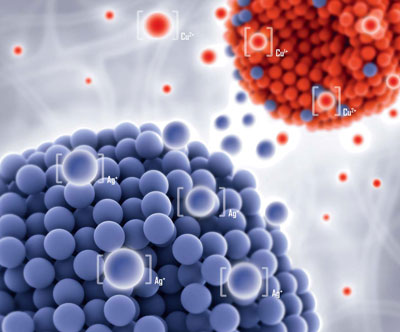| Posted: Jul 08, 2011 | |
A pinch of silver and copper: metal combinations give biomedical silicone strong nano-properties |
|
| (Nanowerk Application Note) Silicone elastomers are widely used for biomedical applications and products. More recently, researchers have even proposed to fabricate implantable nanogenerators on stretchable silicon rubber to power for instance pace makers. | |
| One major challenge for biomedical applications is to control the ingrowth of silicone-based implants and to avoid bacterial infections on device surfaces. The use of ions from metals like silver and copper is a promising, long-lasting method to achieve such bioactive effects. However, in order to prevent potentially harmful effects from an excess of metal ions, tight control of time and quantity of metal ion release is imperative. | |
| Now, researchers in Hannover, Germany, have found a novel effect caused by a combination of copper and silver nanoparticles in silicone. By fabricating bioactive nanocomposite materials that release these ions in specific concentration levels and during a long time, manufacturers can control the bioactive effects of their medical devices or implants. | |
 |
|
| Illustration of metal ion release for time- and rate-controlled design of bioactive nanocomposites. (© RSC Publishing) | |
| Metal nanoparticles embedded into polymers release ions when placed in a wet environment. To achieve a constant and sufficient antibacterial effect at low metal concentrations, a homogeneous distribution of small particles in the polymer is required. This can be realized with the help of laser ablation in liquids – a method for nanoparticle production that has been developed at Laser Zentrum Hannover e.V. (LZH) for several years and is applied commercially by Particular GmbH as the first industrial supplier. | |
| The video below shows an example of Particular's nanoparticle generation technology where gold nanoparticles (giving a red color) are ablated from a piece of gold and dispersed in a solvent. | |
| In their current publication (illustrated on the front cover of Journal of Materials Chemistry 28), Anne Hahn and her colleagues at LZH report on a novel effect by the combination of silver and copper nanoparticles in a silicone elastomer ("Electrochemistry-controlled metal ion release from silicone elastomer nanocomposites through combination of different metal nanoparticles"). | |
| The team achieved an electrochemistry-controlled metal ion release due to an embedding of noble and less noble metal laser-generated nanoparticles of equal concentrations in a silicone matrix. | |
| "Different combinations of the metals can cause retardation and enhancement of released metal ions and are applicable for the time- and rate-controlled design of bioactive nanocomposites," explains Hahn. | |
| Generally, laser ablation in liquids allows the fabrication of nanocomposites from a variety of polymers. At the same time, it allows the generation of a wide range of pure metals nanoparticles that can be combined freely to provide the nanocomposites with different bioactive effects. The researchers at LZH have been developing and testing such materials together with medical and industrial partners, and Particular GmbH is their partner for industrial implementations. | |
 By
Michael
Berger
– Michael is author of three books by the Royal Society of Chemistry:
Nano-Society: Pushing the Boundaries of Technology,
Nanotechnology: The Future is Tiny, and
Nanoengineering: The Skills and Tools Making Technology Invisible
Copyright ©
Nanowerk LLC
By
Michael
Berger
– Michael is author of three books by the Royal Society of Chemistry:
Nano-Society: Pushing the Boundaries of Technology,
Nanotechnology: The Future is Tiny, and
Nanoengineering: The Skills and Tools Making Technology Invisible
Copyright ©
Nanowerk LLC
|
|
|
Become a Spotlight guest author! Join our large and growing group of guest contributors. Have you just published a scientific paper or have other exciting developments to share with the nanotechnology community? Here is how to publish on nanowerk.com. |
|
